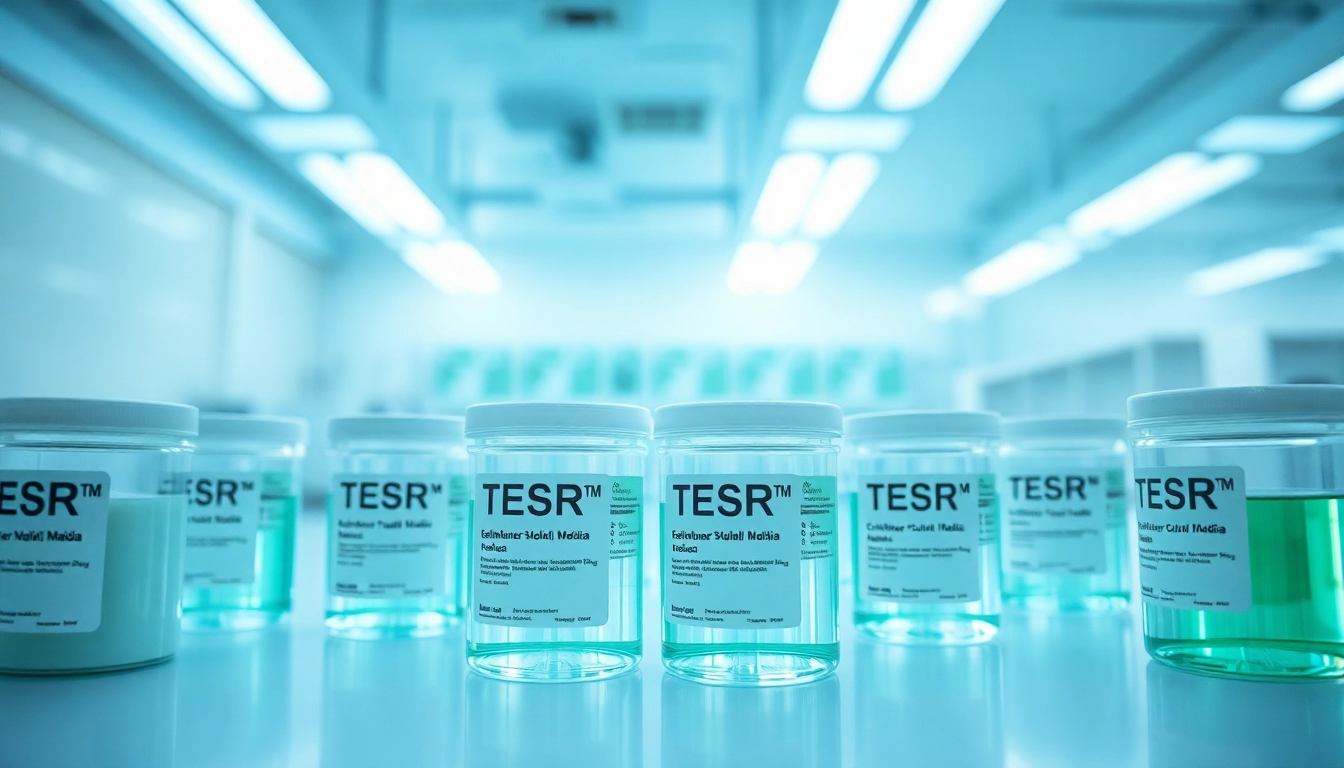Understanding TeSR™ Media Family
Introduction to Pluripotent Stem Cells
Pluripotent stem cells (PSCs) are a unique class of stem cells with the capacity to differentiate into any cell type found within the body, given the right conditions. This remarkable ability to transform is valuable for various applications in regenerative medicine, disease modeling, and drug discovery. The harnessing of PSCs for therapeutic and research purposes depends heavily on the culture conditions they are maintained in. The TeSR™ family of feeder-free culture media, developed by STEMCELL Technologies, provides an advanced, reliable solution for cultivating human embryonic stem cells (hESCs) and induced pluripotent stem cells (iPSCs). For a seamless experience in selecting the right media for your needs, consider exploring all check options available.
Key Components of TeSR™ Culture Media
The success of hPSC culture relies on optimized media formulations that support the unique needs of pluripotent cells. TeSR™ media incorporate high-quality components, including growth factors, buffering agents, and vitamins essential for cellular growth and maintenance.
1. Growth Factors: Key players such as basic fibroblast growth factor (bFGF) are vital for sustaining the pluripotency of stem cells. These factors promote cellular proliferation without triggering differentiation.
2. Buffer Systems: Effective buffering systems minimize pH changes in the culture medium, which is crucial for maintaining cell viability and function.
3. Nutrients and Supplements: The media are rich in essential nutrients that support metabolic functions and enhance cellular yields. They also include vitamins and minerals necessary for cellular health.
With these components, TeSR™ media offer a comprehensive environment that supports the maintenance, differentiation, and cryopreservation of PSCs.
Benefits of Feeder-Free Culturing
Feeder-free culturing presents several advantages over traditional methods, including:
– Reduced Risk of Contamination: By eliminating feeder cells, the likelihood of microbial contamination is significantly decreased, leading to cleaner cultures.
– Consistency in Cell Behavior: Feeder-free systems allow for greater consistency in cellular responses, providing reproducibility in experimental results.
– Simplified Procedures: With defined media like TeSR™, researchers can standardize procedures, making experiments easier to replicate.
– Enhanced Scalability: Feeder-free media facilitate larger-scale cell production, which is necessary for clinical applications.
In conclusion, the TeSR™ media family represents a significant advancement in the cultivation of hPSCs, ensuring that researchers can maintain high-quality cell cultures with reliability and ease.
Types of TeSR™ Media and Their Applications
Overview of mTeSR™ Plus and Its Features
mTeSR™ Plus is a specially formulated maintenance medium designed to support the growth of hPSCs in a feeder-free environment. It features several key attributes:
– Enhanced pH Buffering: This medium has an improved buffering capacity that reduces acidification over time, preserving cell quality during extended culture periods.
– Stabilized Components: Formulations include stabilized growth factors that maintain their efficacy longer, allowing for fewer media changes and enhanced cell viability.
– Pre-screened Materials: To ensure consistency and reproducibility, mTeSR™ Plus is manufactured using rigorously pre-screened components.
The application of mTeSR™ Plus significantly simplifies the workflow for researchers focused on stem cell research, particularly for those facing time constraints.
TeSR™-E8™ and Its Role in Maintenance
TeSR™-E8™ is another vital media offering designed specifically for the maintenance of hPSCs. Some of its characteristics include:
– Minimalism: This medium contains only the essential components required for maintaining hPSCs, reducing the complexity in handling cell cultures.
– Xeno-Free: By being xeno-free, TeSR™-E8™ is safe to use, especially in clinical contexts where viral transmission is a concern.
Research has shown that TeSR™-E8™ offers excellent performance metrics in maintaining stem cell pluripotency and should be considered when selecting media for prolonged cultures.
Applications of TeSR™ in Cell Differentiation
Differentiating hPSCs into specialized cell types is a crucial aspect of regenerative medicine. TeSR™ media are tailored to meet the varied needs of stem cell differentiation:
– TeSR™-E5 and TeSR™-E6: Designed for specific lineages, these formulations facilitate the differentiation of hPSCs into endothelial and neurogenic lineages, respectively. Their unique compositions support the biochemical cues necessary for effective lineage specification.
– ReproTeSR™: For reprogramming adult somatic cells into iPSCs, ReproTeSR™ provides an optimized environment, enhancing efficiency and success rates in generating iPSCs.
Overall, the TeSR™ media family’s versatility allows researchers to undertake numerous differentiation protocols while maintaining cell integrity and function.
Comparative Analysis of TeSR™ Media
How TeSR™ Stands Out from Competitors
In a crowded marketplace of stem cell culture media, TeSR™ differentiates itself based on the following attributes:
– Robust Formulations: Developed from extensive research, TeSR™ products use rigorously validated formulations that prioritize cell health and performance.
– Industry Recognition: TeSR™ media have been referenced in over 1100 peer-reviewed publications, indicating their reliability and effectiveness in stem cell research.
– Support from STEMCELL Technologies: Users benefit from the scientific expertise of STEMCELL Technologies through technical support and product education, making it easier to adopt these formulations in various lab settings.
Performance Metrics: Consistency and Reproducibility
Key performance metrics of TeSR™ media include:
– Batch-to-Batch Consistency: TeSR™ media is designed to provide the same performance in every batch, essential for experiments requiring high reproducibility.
– Cell Growth Rates: Trials demonstrate that cells maintained in TeSR™ media have superior growth rates compared to those cultured in competitor media, ensuring quicker experimental timelines.
– Pluripotency Assessment: Regular assessments reveal consistently high levels of pluripotency markers across all cell lines maintained in TeSR™ media, underscoring their effectiveness in preserving stem cell characteristics.
Case Studies: Successful Use of TeSR™ Media
Numerous studies illustrate the advantages of TeSR™ media:
– Cardiac Differentiation: A recent study utilizing mTeSR™ and TeSR™-E5 highlighted successful differentiation of iPSCs into functional cardiomyocytes, crucial for heart disease therapies.
– Modeling Disease: Researchers have effectively employed TeSR™ media for modeling diseases like ALS using patient-derived iPSCs, establishing disease-specific cellular phenotypes.
These case studies underline not only the versatility but the real-world impact of the TeSR™ media family in advancing stem cell research.
Optimizing hPSC Culture with TeSR™
Best Practices for Media Preparation
For successful hPSC cultures, best practices must be followed:
1. Thorough Mixing: Ensure that all components are thoroughly mixed to prevent local variations in pH and nutrient concentrations.
2. Sterile Handling: Maintain sterile conditions throughout media preparation to avoid contamination that could compromise cell health.
3. Filtration: Use 0.22 µm filters to sterilize media before use, ensuring all pathogens are removed.
Implementing these practices ensures a consistent and viable culture environment for stem cells.
Monitoring Cell Health and Growth
Monitoring their health is vital in maintaining optimal conditions for hPSCs:
– Visual Inspections: Regularly observe cell morphology; healthy stem cells should appear compact with a high nucleus-to-cytoplasm ratio.
– Viability Assays: Utilize assays such as trypan blue exclusion to assess cell viability, ensuring that low viability doesn’t impact experimental outcomes.
– Karyotyping: Routine karyotyping is necessary to confirm genomic stability, a crucial indicator of stem cell quality.
These monitoring strategies help researchers maintain high-quality hPSC cultures effectively.
Innovative Techniques in Stem Cell Research
The field of stem cell research is continually evolving with new techniques:
– 3D Culture Systems: Novel 3D culture platforms like mTeSR™3D promote more physiological behavior in hPSCs, allowing for better modeling of tissues and diseases.
– Automated Systems: Adoption of automated culture systems offers enhanced consistency and reduced hands-on time for researchers, allowing for high-throughput applications.
– Gene Editing: The interplay of stem cells with CRISPR technology allows for precise editing of genomic sequences, advancing research in genetic disorders and therapeutic applications.
Incorporating these innovations can lead to more impactful discoveries while optimizing research workflows.
Future of Stem Cell Technologies
Emerging Trends in Feeder-Free Culturing
The future of stem cell culture is bright, with several emerging trends shaping research:
– Biomaterials: New biomaterials are being developed that can mimic the stem cell niche, providing enhanced growth conditions.
– Artificial Intelligence: AI-driven algorithms are beginning to influence culture approaches, predicting optimal culture conditions and reducing experimental failures.
– Personalized Medicine: The growing trend toward personalized medicine is amplifying the role of stem cells in developing tailored therapies for patients.
These trends point to a dynamic future where stem cell technologies will integrate more seamlessly with clinical applications.
Potential Challenges and Solutions
Despite the progress, challenges persist:
– Scalability: As demand for stem cells grows, ensuring scalable methods for production is essential. Solutions involve optimizing culture conditions in bioreactors to meet increased demand.
– Quality Control: Ensuring consistent quality across batches remains a top concern. Implementing rigorous quality control protocols helps maintain high standards across all production stages.
By identifying potential challenges early and adopting proactive solutions, researchers can continue to advance stem cell technologies effectively.
Long-Term Vision: Integrating TeSR™ with Clinical Applications
The ultimate aim of stem cell research is to translate findings into clinical applications. As TeSR™ media continue to evolve, they are poised to play a critical role in achieving this vision:
– Collaborative Research: By collaborating with various academic and industry partners, the development of TeSR™ products will continue driven by current research needs and clinical insights.
– Regulatory Frameworks: As the field advances, complying with regulatory standards becomes paramount. Ensuring that TeSR™ media meet cGMP requirements is crucial for clinical success.
– Therapeutic Applications: The transition from bench to bedside will require a focus on translational research, leveraging TeSR™ media in developing cellular therapies for conditions such as Parkinson’s disease, spinal cord injuries, and more.
In conclusion, the TeSR™ family of media represents a significant advancement in the field of stem cell research, paving the way for innovations that will benefit clinical applications. By understanding and optimizing these media, researchers can drive their research forward, ultimately leading to groundbreaking therapeutic solutions.



